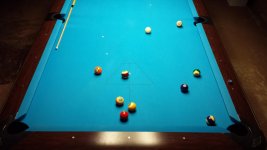Not much going on lately so I thought I'd post a photo and see if any discussion of interest develops:
In the photo below, there are no problems with the layout. The 5 is the break ball and every ball has a pocket to go to. The 11 is near the side pocket, and it is the 15 inside the rack area, just to be clear.
We all know about safety balls - those balls that assure you a shot after you open up a cluster, for instance. How about a safety pocket? In the photo, there are 7 balls fairly close together that pretty much have to go in one of the two corner pockets. If I get rid of the 11 first, it COULD happen that I get on the wrong side of a ball, and end up having to cut a ball into an upper corner pocket. The 11 is close enough to the side pocket that almost no matter where I am with the cue ball (certainly anywhere to the left of the 4 ball), I can make that 11 in the side. So if I leave the 11 it becomes a safety ball, or what you could call a safety pocket. 7 balls have only 2 pockets to go into, so maybe it is nice to have a 3rd pocket option if something goes wrong.
It's a little like how some like to leave a ball near the foot rail as a safety ball. Actually I never really understood that one, so if someone could clear me up on that I'd appreciate it.
Any comment on this, or am I just blathering?
FWIW, my sequence was: 4, 12, 3 draw, 9 draw, 13 follow to left rail, 11, 14, 15 stun over for break on 5, miss the 5 and bang head on table.
In the photo below, there are no problems with the layout. The 5 is the break ball and every ball has a pocket to go to. The 11 is near the side pocket, and it is the 15 inside the rack area, just to be clear.
We all know about safety balls - those balls that assure you a shot after you open up a cluster, for instance. How about a safety pocket? In the photo, there are 7 balls fairly close together that pretty much have to go in one of the two corner pockets. If I get rid of the 11 first, it COULD happen that I get on the wrong side of a ball, and end up having to cut a ball into an upper corner pocket. The 11 is close enough to the side pocket that almost no matter where I am with the cue ball (certainly anywhere to the left of the 4 ball), I can make that 11 in the side. So if I leave the 11 it becomes a safety ball, or what you could call a safety pocket. 7 balls have only 2 pockets to go into, so maybe it is nice to have a 3rd pocket option if something goes wrong.
It's a little like how some like to leave a ball near the foot rail as a safety ball. Actually I never really understood that one, so if someone could clear me up on that I'd appreciate it.
Any comment on this, or am I just blathering?
FWIW, my sequence was: 4, 12, 3 draw, 9 draw, 13 follow to left rail, 11, 14, 15 stun over for break on 5, miss the 5 and bang head on table.
